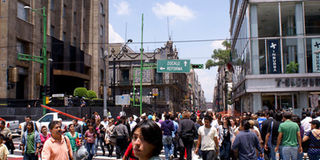Neat streets, sleek cars and orderly bus service

A street in Mexico near where the writer is residing. NET PHOTO
What you need to know:
WINDOW ON MEXICO. This is the journal of Julius Ocwinyo, author of Fate of the Banished among other books, and an associate editor at Fountain Publishers who is on a writer-in- residence programme in Mexico.
Upon arrival at New Mexico Airport, the biggest in Latin America, I had set my watch to Mexican time, but I had kept my mobile phone on Ugandan time. I noticed that it was 9.45 pm. by my watch. I looked at the time on my mobile and realised that it was 6.45 am. Soon after, feeling exhausted and disoriented, probably owing to jet lag, I slumped into bed.
Getting used to my lodgings
The sun rises sooner than I thought it would. Perhaps I had slept too soundly to notice the passage of time. It is chilly, the air is dry, there is no snow. I’m struck by the predominant smell of my neighbourhood: it is spicy. I contrast this with the smell of the parts of Lagos, Nigeria, where I had stayed on my two trips there: it has a hint of semen to it.
I check out my new lodgings, a beautiful, one-bedroom flat with amber and white walls and leather sofas. It has everything I need to be comfortable. There is a bottle of tequila on top of the fridge. I ask myself: What are you going to do with this since you swore off spirits decades ago? Inside the fridge I espy two bottles of beer. The brand is called Barrilito and it comes in small bottles the shape of an avocado. These ones I am happy about.
My flat is located smack in the city centre, the Centro Historico, which abounds with historical sites. It is on a street named Calle de Republica de Cuba. Beneath it is a parking yard with two car lifts that hoist cars from street level to the third floor – one floor beneath mine. Two parking attendants take care of everything. I can see, beyond the car park, Hotel Congreso, that had been swarming with noisy fun-seekers the previous night when I arrived, with Latin-American music pulsing out of it.
Impressive streets
I look out of one of my living-room windows down on the street. There is a long line of red bicycles with white mudguards shackled to a railing. I suspect they are intended for hire. I see movement on the balcony of the flat directly across from mine. A decrepit old man has emerged, shuffling, and is draping clothes, some of which look dry, over the balustrade.
I’m struck by the neatness of the street, the sleekness of the cars, the age of many of the buses. Most of the cars look new, few are white, and they sound like they have big engines – six- or eight-cylinder ones – and are predominantly American and European. The Volkswagen Beetle seems to be the iconic car here.
It seems to be treated with a lot of respect and affection, and is frequently pimped up. The buses, green-and-white in hue, are loud, and some are quite old. There are bicycles too, green covered ones with three wheels – a favourite with tourists, I am to learn later –, sports bikes, and the Roadmaster-type ones that in Uganda would be used for transporting bunches of bananas to the market. Frequently a high-powered motorbike screams past.
A restrained impatience marks the conduct of the motorists here. They have immense respect for the pedestrians, cyclists and traffic lights. However, once the lights turn green, there is frantic hooting, urging the motorists at the front to hurry up.
Later in the day, Koulsy Lamko introduces me to two of the people I will working with, Palmira and Merely. The former speaks a lot of English; the latter’s English is a little limited.
I am told she is studying Hebrew so as to better be able to understand Jewish culture. The three promise to take me out to a typical Mexican lunch in the course of the week.




